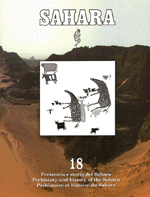| Contents
Abstracts |
Abstracts of Sahara volume 18
(published May 2007)
|

|
Michael Brass
Reconsidering the emergence of social complexity in early Saharan pastoral societies, 5000-2500 B.C
ABSTRACT
Debates on the subject of cultural complexity and its material manifestations are situated at the centre of research on prehistoric pastoralism in North Africa. Employing already published databases, this article integrates raw data from archaeological sites across the Sahara with ethnography to generate a framework of analysis in which changes in material culture can be interpreted. It attempts to establish a relationship between the analysis of human and cattle remains in order to study (a) the relations between modes of interment of animals and of humans, and social changes, and (b) the processes responsible for the appearance of a symbolism of power in the mid- and late Holocene funerary rituals. Their integration with landscape systems results in a conclusion of complex patterns of cultural diversity which question previous dismissals of early Saharan pastoralists as the progenitors of social complexity.
|
|
Top
|
Birgit Keding, Tilman Lenssen-Erz and Andreas Pastoors
Pictures and pots from pastoralists.
Investigations into the prehistory of the Ennedi highlands in NE Chad
ABSTRACT
Since 2003 members of the ACACIA research program of the University of Cologne have passed three seasons of field research in the Ennedi highlands, NE Chad, mainly in the central and eastern parts of the region. The large number of new discoveries includes 148 rock art sites that were recorded during the research, among them 132 hitherto unknown sites. Systematic surveying also led to the discovery of 262 new archaeological sites and seven excavations were carried out. This paper gives a rough overview of the discoveries, their character and a first assessment as to their potential for new insights into the cultural history of the Ennedi highlands during the Holocene.
|


Top
|
Alessandro Menardi Noguera, Stefano Laberio Minozzi and Michele Soffiantini
Old tracks and rock art sites on the Emeri Highland, Jebel Uweinat (Libya)
ABSTRACT
The Emeri Highland, in the Libyan sector of Jebel Uweinat, preserves important evidence of the ancient and modern African peoples, who exploited the environment of the high plains hidden within the massif. As a result of the 2006 spring reconnaissance, many new rock art sites were discovered. In addition to the sites referable to the «Uweinat Pastoralist» style, the first high-altitude paintings that can be attributed to the more ancient and less widespread «Uweinat Roundhead» style were found. Thanks to the extensive application of digital image processing techniques, it has been possible to evidence also the presence of paintings referable to the «Small Human Figures» style. The high-resolution satellite images employed for the reconnaissance allowed the individuation and survey of the only existing track to the Emeri Highland practicable with a beast of burden. This mule track, first reported in 1934 by Prof. Umberto Mònterin, followed by Tebu nomads during recent historical times, was very likely traced by the Neolithic peoples, who created the rock art gallery of Jebel Uweinat.
|
|
A. José Farrujia de la Rosa and Sergio García Marín
The rock art site of Risco Blanco (Tenerife, Canary Islands) and the Saharan Horsemen Cycle
ABSTRACT
In this paper we analyse the rock art site of Risco Blanco (Santiago del Teide, Tenerife), recently discovered and previously unpublished. We consider the parallels that can be established with the Saharan Horsemen Cycle and therefore with the Zenaga or Azanegh populations who occupied the area surrounding these examples of rock art. We also propose an interpretation of this archaeological site and point out the theoretical and methodological problems that rock art studies have to deal with, especially in environments similar to the Canary Islands.
|
|
Top
|
Jean-Pierre Duhard
À propos de labrets néolithiques en pierre du Sahara malien
ABSTRACT
The analysis of a group of 42 labrets from Malian Sahara offers an occasion to evoke the history of these adornments for facial lips, the medical consequences of their use and their meaning.
|
|
Top
|
Richard Wolff
Les gravures rupestres de «nasses» et l’étui pénien: quelques éclaircissements
ABSTRACT
In this paper we take up the theme of the so-called ‘nasses’, since discoveries of images of these enigmatic objects increased in the last ten years. To get over an unsubstantiated statement, a review of some interpretations is carried out. As a possible explanation, the penis sheath finds some confirmation in the T-shaped rock engravings when they are compared to the sheaths of some Amazon Indians. However, this evidence does not concern all the ‘nasse’ shapes. As far as the sheath certainly worn by the Tazina-style engraved hunters is concerned, the hypothesis is not confirmed when the ‘nasses’ are simplified and shown as an emblem above the fauna.
|

|
François Soleilhavoup
Les pseudo-nasses: gravures énigmatiques du Sahara préhistorique
ABSTRACT
In French, the word «nasses» (=fish traps) has been used for long to name some Saharan engravings in the shape of a gourd or an almond, with or without appendices at their narrow end. As these figures do not at all look like fish or shellfish traps, we suggest to call such engravings «pseudo-nasses». Distributed all over the Sahara, these drawings (things? signs? symbols ?) actually appear in a variety of shapes which, perhaps, match with local variants of a Neolithic culture characterized by the so-called «Tazina» rock art style. After a review of the main types of «pseudo-nasses» situated in the main Saharan areas, from Morocco to Sudan, including the entry of a few discoveries in the Libyan Fezzan, a list of the various interpretations proposed by different authors is given and the additional suggestion of a bag or a pouch is advanced. But in spite of these attempts, the question of the interpretation of the «pseudo-nasses» is probably to remain unsolved for a long time.
|
|
Top
|
El Hassan Ezziani
Une application d’un modèle sémiotique à l’art rupestre.
Les gravures rupestres du Haut Atlas (la vallée de l’Ourika, Maroc)
ABSTRACT
The High Atlas prehistoric petroglyphs, as any other prehistoric «art», clash against the problem of meaning. For the sake of rigour, some researchers just identify, classify and date. They consider these expressions as a mere documental database. Others think they detain a mine of symbols. Researchers who consider themselves strict are not starting a process of interpretation when they name signs? Because attributing a name implies giving a meaning. A disk can mean «sun, shield, blazon» etc. To identify this disk with a hunt rather than a war tool radically modifies the classification. As the danger of interpretation is inevitable, one has to face it, without anyway falling into riducule. It would be interesting to know how meaning is generated, rather than knowing the meaning itself of the art; in other words, it would be preferable to take into account its architecture and structure. A suitable work-tool is necessary, as each «art» has specific characters. For my part, before classifying, dating, etc. (Ezziani, 2002, 2004a et b) the High Atlas petroglyphs, I tried to reduce the dangers of identification to the minimum. The work-tool I applied is a semiotic model drawn from structuralism and linguistics.
|
|
|

http://www.saharajournal.com
e-mail: reception@saharajournal.com
Last update Monday, September 2, 2013
|
|
|
|

